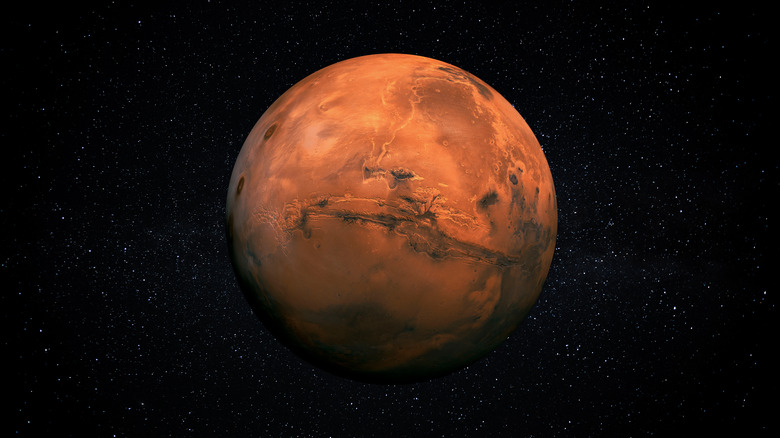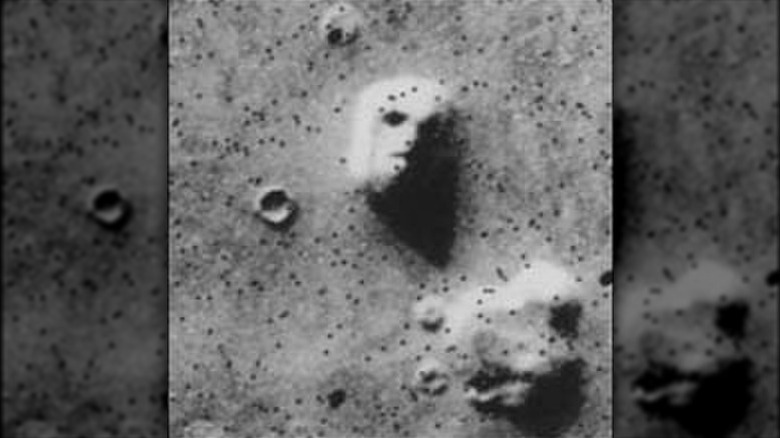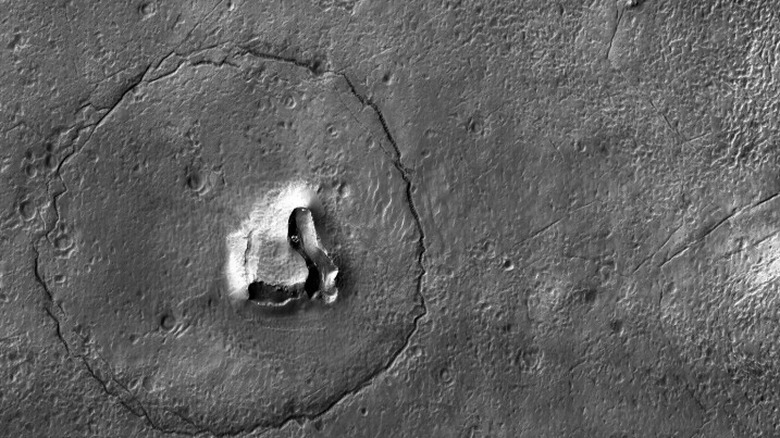Humans See Recognizable Shape On Mars In Reconnaissance Orbiter's Recent Photo
An instance of pareidolia occurred when NASA's Reconnaissance Orbiter spacecraft sent back photos from Mars in late 2022. Tasked with finding evidence of water on Mars while gathering data on Martian weather and climate, NASA's Reconnaissance Orbiter spacecraft transmitted pictures that looked to some people like the face of a common animal, according to CNN. This was just the latest example of a type of apophenia called pareidolia related to Mars, or the natural human tendency to ascribe familiar shapes to what are really just randomized patterns.
Pareidolia, or apophenia with visual input, is the same reason many see faces or other objects in formless cloud shapes, as Masterclass writes. Other examples of apophenia include confirmation bias, clustering illusion, and gambler's fallacy. The "Man in the Moon" or the fact many people see the face of a person on the Moon's surface from Earth is another example, as are star constellations. Pictures from the Orbiter were revealed on the Arizona State University website. The project was part of ASU's Lunar and Planetary Laboratory, and the recognizable shape was even pointed out in the school's announcement.
The Face on Mars
Next to the images captured by the Reconnaissance Orbiter, another instance of pareidolia on Mars involved the illusion of a face, per NASA. In 1976, NASA's Viking 1 spacecraft captured a picture of the Martian surface from the Cydonia region, and in it, many saw what looked like a giant face possibly carved into the planet's surface (pictured above). If that had been the case, it would have been miles long. As those images spread widely, proof had finally been found, according to some, that an ancient civilization once inhabited Mars and that the Viking 1 image captured one of their monuments. Even NASA described it as looking something like a human head (via Space).
The image dubbed the "face on Mars" was really just a geologic formation, though, that in its shape and shading caused viewers to see a face due to the pareidolia effect. Twenty years later, a closer examination of more detailed pictures from space revealed the "face on Mars" was nothing more than an optical illusion. Other lesser-known examples of pareidolia on Mars include a smiley-face-looking mountain range, lava flow resembling Kermit the Frog, and a skull-shaped mesa, as Space writes. In 2022, the Curiosity rover returned pictures that looked strikingly like a flower but what was really a rock formation caused by minerals and water from sometime in Mars' distant past, as CNN goes on to report.
The Reconnaissance Orbiter pictures look like a bear
As far as the Orbiter example of pareidolia from ASU, the picture in the opinion of some seemed to depict a rounded bear's head with two eye-like impressions and something that looked a bit like a bear's nose and mouth, as can be seen above. In reality, the supposed bear eyes were also reportedly craters. What the nose and mouth-like object could be was not immediately clear, but it was theorized to possibly be a collapsed lava or mud vent, as CNN writes. The round shape was plausibly a surface fracture, according to CBS News. It all measured a bit more than a mile wide.
The images first shown at the University of Arizona were taken by the Orbiter's HiRISE camera, able to see down to only a few feet from hundreds of miles above Mars' surface, according to CNN. In addition to pareidolia, of which the bear-on-Mars face is one example, other kinds of apophenia are gambler's fallacy, or seeing patterns in numbers that aren't there; clustering illusion, or finding patterns in data that don't exist; and confirmation bias, testing a hypothesis while presuming from the outset it's correct. As we push deeper and deeper into the galaxy with more hi-res imagery coming our way, it's likely what seemed to be a bears face on Mars won't be the last example of pareidolia we encounter from space.


